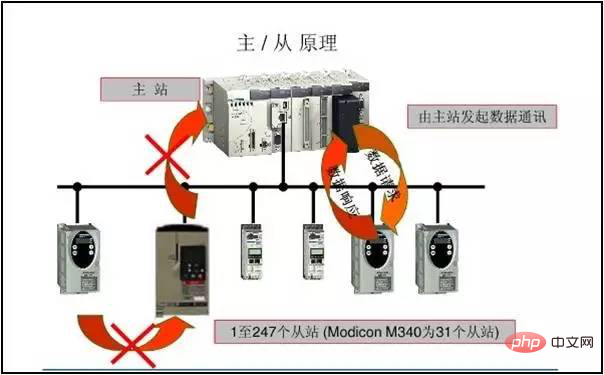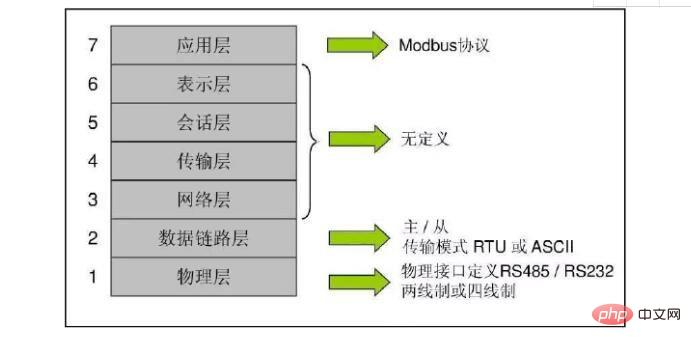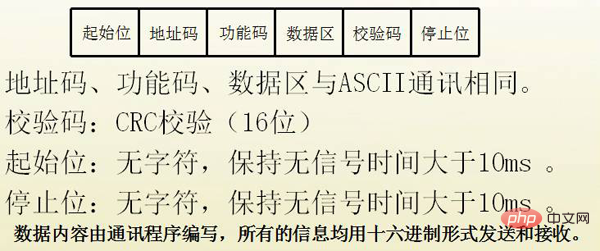What are the 5 industrial communication protocols?
5 kinds of industrial communication protocols: 1. Modbus protocol, which is a universal language used in electronic controllers; 2. RS-232 protocol, which is a serial physical interface standard; 3. RS- 485 protocol is developed on the basis of RS232; 4. HART protocol is a communication protocol used between on-site intelligent instruments and control room equipment; 5. MPI protocol is a cross-language communication protocol, used for writing parallel computers.

The operating environment of this tutorial: Windows 7 system, Dell G3 computer.
Industrial communication protocols refer to the rules and agreements that both entities in the industrial control field must follow to complete communications or services.
5 kinds of industrial communication protocols: modbus communication protocol, RS-232 communication protocol, RS-485 communication protocol, HART communication protocol, MPI communication
Modbus Communication Protocol
The Modbus protocol was originally developed by Modicon. In late 1979, the company became part of the Schneider Automation Department. Now Modbus is the most popular protocol in the industrial field in the world. This protocol supports traditional RS-232, RS-422, RS-485 and Ethernet devices.
Because the Modbus protocol is completely open and transparent, and the required software and hardware are very simple, it has become a universal industry standard. Many industrial equipment, including PLC, DCS, smart meters, etc., are using the Modbus protocol as the communication standard between them. With it, control equipment produced by different manufacturers can be connected into an industrial network for centralized monitoring.
Features
Modbus protocol is a universal language applied to electronic controllers. Through this protocol, controllers can communicate with each other, with controllers and other devices via a network (such as Ethernet). It has become a common industry standard. This protocol defines a message structure that controllers understand to use, regardless of the network over which they communicate.
Modbus communication protocol is a master-slave asynchronous half-duplex communication protocol. It adopts a master-slave communication structure, which allows one master station to communicate with multiple slave stations for two-way communication. It describes the process by which a controller requests access to other devices, how to respond to requests from other devices, and how to detect and log errors. It establishes a common format for message domain layout and content.
The Modbus protocol includes ASCII, RTU and other communication methods, but does not specify the physical layer. This protocol defines the message structure that controllers can understand and use regardless of the network over which they communicate. The standard Modicon controller uses RS232C to implement serial Modbus. The ASCII and RTU protocols of Modbus stipulate the structure of messages, data, commands and response methods. Data communication adopts the master-slave mode. The master station sends a data request message, and the slave station can send data to the master station after receiving the correct message. To respond to the request; the master station can also directly send messages to modify the data of the slave station to achieve bidirectional reading and writing.

When communicating on a Modbus network, this protocol determines that each controller needs to know their device address, identify messages sent by address, and determine what should occur. What kind of action. If a response is required, the controller will generate feedback information and send it using the Modbus protocol. On other networks, messages containing the Modbus protocol are converted into the frame or packet structure used on that network. This transformation also extends the method of resolving stanza addresses, routing paths, and error detection on a specific network basis.
When communicating on the network, the Modbus protocol determines that each controller needs to know their device address, identify messages sent by address, and decide what actions to take. If a response is required, the controller will generate a reply and send it to the interrogating party using the Modbus protocol.
Modbus protocol requires data verification. In addition to parity check, the serial protocol uses LRC verification in ASCII mode and 16-bit CRC verification in RTU mode. In addition, Modbus uses a master-slave mode to regularly send and receive data. In actual use, if a slave station is disconnected (such as failure or shutdown), the master can diagnose it, and when the fault is repaired, the network can be automatically connected again. Therefore, the Modbus protocol has better reliability.
Modbus and OSI reference model
ASCII communication method of Modbus




RS-232 communication protocol
RS-232 is developed by the Electronic Industry Association EIA (Electronic Industry Association) A serial physical interface standard. RS is the abbreviation of "Recommended Standard" in English, and 232 is usually the identification number. The RS-232 interface appears in the form of 9 pins (DB-9) or 25 pins (DB-25). Generally, there are two sets of RS-232 interfaces on personal computers, called COM1 and COM2 respectively.
RS-232 interface
The RS-232 standard has 25 signal lines and 9 signal lines, including a main channel and an auxiliary channel. In most cases, the main channel is mainly used. For general duplex communication, only a few signal lines can be implemented, such as a transmitting line, a receiving line and a ground line.
Transmission rate
The data transmission rates specified by the RS-232 standard are 50, 75, 100, 150, 300, 600, 1200, 2400, 4800 , 9600, 19200 baud rate.
Remote communication connection data terminal
The RS-232 standard was originally developed for remote communication connection data terminal equipment (DTE) data communication equipment (DCE). Therefore, the formulation of this standard did not consider the application requirements of computer systems. But now it is widely used as a near-end connection standard between computers (more precisely, computer interfaces) and terminals or peripherals. Obviously, some provisions of this standard are inconsistent with or even contradictory to computer systems. With this background understanding, it is not difficult to understand why the RS-232C standard is incompatible with computers.
RS-232 Disadvantages:
(1) The signal level of the interface is relatively high, which easily damages the chip of the interface circuit, and is incompatible with TTL levels. Therefore, a level conversion circuit is required to connect to the TTL circuit.
(2) The transmission rate is low. During asynchronous transmission, the baud rate is ≤20Kbps.
(3) The interface uses a signal line and a signal return line to form a common ground transmission form. This type of common ground transmission is prone to common mode interference, so its immunity to noise interference is weak.
(4) The transmission distance is limited, and the standard maximum transmission distance is 50 feet (actual ≤ 15 meters).
RS-485 Communication Protocol
The RS-485 standard is developed on the basis of RS232, adding multi-point and two-way communication capability, which allows multiple transmitters to be connected to the same bus, while increasing the drive capability and conflict protection features of the transmitter, expanding the common mode range of the bus, and was later named the TIA/EIA-485-A standard.
Electrical characteristics of RS-485:
Logic "1" is represented by the voltage difference between the two lines being (2-6) V; logic "1" 0" is expressed by the voltage difference between the two lines being - (2-6) V. The interface signal level is lower than that of RS-232, which makes it less likely to damage the chip of the interface circuit. Moreover, the level is compatible with the TTL level and can be easily connected to the TTL circuit.
Transmission rate:
The maximum data transmission rate of RS-485 is 10Mbps
RS-485 interface:
It uses a combination of balanced driver and differential receiver, which has enhanced anti-common mode interference capability, that is, good anti-noise interference.
Baud rate:
1200bps, 2400bps, 4800bps, 9600bps, 19200bps, 38400bps, 125K
Communication interface mode :
Disadvantages:
In many cases, connecting RS -485 communication link simply uses a pair of twisted pairs to connect the "A" and "B" ends of each interface. The connection to the signal ground is ignored. This connection method can work normally in many situations, but it buries a great hidden danger of common mode interference: the RS-485 interface uses a differential signal transmission method and does not require relative To detect the signal at a certain reference point, the system only needs to detect the potential difference between the two lines. But people often ignore that the transceiver has a certain common-mode voltage range. The common-mode voltage range of the RS-485 transceiver is -7~12V. Only when the above conditions are met, the entire network can work normally. When the common-mode voltage in the network line exceeds this range, it will affect the stability and reliability of communication, and even damage the interface.HART protocol
HART (HighwayAddressable Remote Transducer), an open communication protocol for addressable remote sensor high-speed channels, is a product of the American ROSEMOUNT company. A communication protocol introduced in 1985 for use between field smart instruments and control room equipment. HART devices provide communication with relatively low bandwidth and moderate response time. After more than 10 years of development, HART technology has become very mature abroad and has become the industry standard for global smart instruments.The HART protocol uses the FSK frequency shift keying signal based on the Bell202 standard, superimposing an audio digital signal with an amplitude of 0.5mA on the low-frequency 4-20mA analog signal for two-way digital communication, with a data transmission rate of 1.2Mbps. Since the average value of the FSK signal is 0, it does not affect the size of the analog signal transmitted to the control system, ensuring compatibility with existing analog systems. In the HART protocol communication the main variables and control information are transmitted by 4-20mA. If necessary, additional measurements, process parameters, device configuration, calibration and diagnostic information are accessed through the HART protocol.
Communication model:
##MPI communication protocol
MPI is a cross-language communication protocol for writing parallel computers. Supports point-to-point and broadcast. The goals of MPI are high performance, large scale, and portability. MPI remains the main model for high-performance computing today. MPI protocol, its full English name is MulTI-point-Interface. Master/master protocol or master/slave protocol can be configured between PLCs. How to operate depends on the device type: If the control stations are all s7-300/400 series PLCs, then establish a master/master connection relationship. Because the MPI protocol supports multi-master communication, all s7-300 CPUs can be configured as network masters. Station, data exchange between PLCs can be realized through the master/master protocol. If some control stations are s7-200 series PLCs, a master/slave connection relationship can be established. Because the s7-200 CPU is a slave station, the user can realize the data reading and writing operations of the s7-300 CPU on the s7200 CPU through network instructions. For more related knowledge, please visit theFAQ column!
The above is the detailed content of What are the 5 industrial communication protocols?. For more information, please follow other related articles on the PHP Chinese website!

Hot AI Tools

Undresser.AI Undress
AI-powered app for creating realistic nude photos

AI Clothes Remover
Online AI tool for removing clothes from photos.

Undress AI Tool
Undress images for free

Clothoff.io
AI clothes remover

AI Hentai Generator
Generate AI Hentai for free.

Hot Article

Hot Tools

Notepad++7.3.1
Easy-to-use and free code editor

SublimeText3 Chinese version
Chinese version, very easy to use

Zend Studio 13.0.1
Powerful PHP integrated development environment

Dreamweaver CS6
Visual web development tools

SublimeText3 Mac version
God-level code editing software (SublimeText3)

Hot Topics
 1378
1378
 52
52
 Which protocol does vivo fast charging belong to?
Sep 06, 2022 pm 02:43 PM
Which protocol does vivo fast charging belong to?
Sep 06, 2022 pm 02:43 PM
There are two main protocols for vivo fast charging: 1. "QC 2.0" fast charging protocol. "QC2.0" is "Quick Charge 2.0" technology. It is version 2.0 of fast charging technology released by Qualcomm. It can output 5V, 9V, and 12V. , 20V four voltage groups; 2. PD fast charging protocol is a fast charging specification formulated by the "USB-IF" organization. It is one of the current mainstream fast charging protocols and can make the current default maximum power "5V/2A" The "type-c" interface is increased to 100W.
 What is the maximum watt of PD3.0 fast charging protocol?
Nov 08, 2022 pm 04:04 PM
What is the maximum watt of PD3.0 fast charging protocol?
Nov 08, 2022 pm 04:04 PM
The PD3.0 fast charging protocol supports up to “100W”. In November 2015, USB PD fast charging ushered in a major version update, entering the USB PD3.0 fast charging era; the PD3.0 protocol supports 5V3A, 9V3A, 12V3A, 15V3A, 20V5A output, and the maximum power can reach 100W. Not only can It can be used to charge mobile phones, and can also be used to power laptops or monitors.
 What are the 5 industrial communication protocols?
Sep 28, 2022 am 11:52 AM
What are the 5 industrial communication protocols?
Sep 28, 2022 am 11:52 AM
5 types of industrial communication protocols: 1. Modbus protocol, which is a universal language used in electronic controllers; 2. RS-232 protocol, which is a serial physical interface standard; 3. RS-485 protocol, which is based on RS232 Developed on the basis of; 4. HART protocol is a communication protocol used between on-site intelligent instruments and control room equipment; 5. MPI protocol is a cross-language communication protocol used to write parallel computers.
 SOAP Protocol Guide in PHP
May 20, 2023 pm 07:10 PM
SOAP Protocol Guide in PHP
May 20, 2023 pm 07:10 PM
With the continuous development of Internet technology, more and more enterprise-level applications need to provide interfaces to other applications to realize the interaction of data and business. In this case, we need a reliable protocol to transmit data and ensure data integrity and security. SOAP (Simple Object Access Protocol) is an XML-based protocol that can be used to implement communication between applications in a Web environment. As a popular web programming language, PHP
 What is the qc4+ fast charging protocol?
Aug 18, 2022 pm 03:49 PM
What is the qc4+ fast charging protocol?
Aug 18, 2022 pm 03:49 PM
The QC4+ fast charging protocol is a combination of the USB PD PPS protocol and the QC3.0/2.0 fast charging protocol. It is a multi-functional, multi-protocol fast charging technology. The QC4+ charging protocol is compatible with USB PD3.0 (PPS) and is downwardly compatible with USB PD2.0, QC3.0, QC2.0, BC1.2 and other protocols. The first prerequisite for supporting USB PD and QC4+ is the support of USB-C interfaces at both ends and the power negotiation message based on the CC (configuration channel) in the USB-C interface.
 What technology does the x.25 protocol use?
Jul 18, 2022 pm 04:05 PM
What technology does the x.25 protocol use?
Jul 18, 2022 pm 04:05 PM
The "x.25" protocol uses packet switching technology; the "x.25" protocol is a computer-oriented data communication network, consisting of basic equipment such as transmission lines, packet switches, remote concentrators and packet terminals, and adopts a layered architecture , negotiation, control and information transmission of information exchange are carried out between the peer layers of the interface through the communication protocol between the peer layers.
 Windows will retire TLS 1.0 and TLS 1.1 in the near future
Aug 12, 2023 am 11:37 AM
Windows will retire TLS 1.0 and TLS 1.1 in the near future
Aug 12, 2023 am 11:37 AM
Microsoft plans to disable Transport Layer Security (TLS) protocol versions 1.0 and 1.1 in Windows. The company announced the news on its technology community website on March 1, 2023. These two protocols date back to 1999 (TLS1.0) and 2006 (TLS1.1) and have since been surpassed by newer versions TLS1.2 and TLS1.3. Microsoft noted that security issues were discovered in older protocol versions, and "Internet standards and regulators have deprecated or disallowed TLS versions 1.0 and 1.1 in response. Over the years, usage of TLS 1.0 and 1.1 has declined significantly. , Microsoft believes the time has come to disable both protocols. Mic
 Concise and easy to understand: in-depth analysis of the meaning of pip protocol
Feb 02, 2024 pm 01:10 PM
Concise and easy to understand: in-depth analysis of the meaning of pip protocol
Feb 02, 2024 pm 01:10 PM
To deeply analyze the meaning of the pip protocol, specific code examples are required. Introduction: In the Python world, pip (i.e. pipinstall) is our preferred way to install and manage third-party libraries. It is a Python package management tool. It is widely used in the development process because of its simplicity, efficiency, ease of use and convenience. This article will deeply analyze the meaning of the pip protocol, demonstrate the important role and usage of pip through specific code examples, and help readers better understand and use pip. 1. pip protocol




